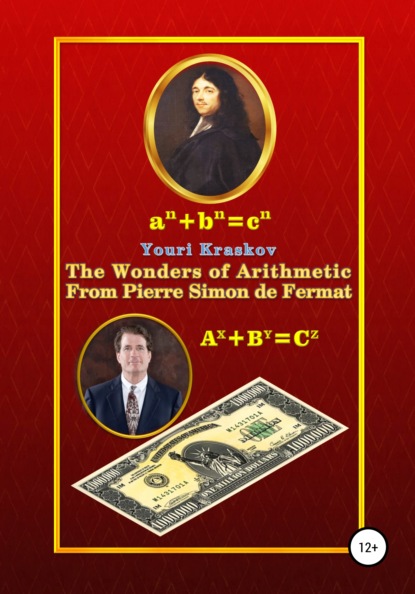По всем вопросам обращайтесь на: info@litportal.ru
(©) 2003-2024.
✖
The Wonders of Arithmetic from Pierre Simon de Fermat
Год написания книги
2021
Настройки чтения
Размер шрифта
Высота строк
Поля
(P–9)–6?
P–?
=2 (5)
Here one can no longer doubt that this will continue without end. Indeed, by trying ?
=P each time we get P
(P?K
)>2. Whatever the number of K
this equation is impossible because if K
<P and P>3 then P
(P?K
)>2 and if K
?P then this option is excluded because then P
(P?K
)?0
To continue so infinitely is clearly pointless, therefore our initial assumption of the existence of another solutions P>3, Q>5 is false and this Fermat's theorem is proven.
In the book of Singh, which we often mention, this task is given as an example of the “puzzles” that Fermat was “inventing”. But now it turns out that the universal descent method and a simple technique with trying, make this task one of the very effective examples for learning at school.
Along with this proof, students can easily prove yet another theorem from Fermat’s letter-testament, which could be solved only by such a world-famous scientist as Leonard Euler:
There are only two squares that increased by 4, give cubes, these squares will be 4 and 121.
In other words, the equation p
=q
+4 has only two integer solutions.
3.4.2. The Fermat’s Golden Theorem
We remind that in the Fermat's letter-testament only a special case of this theorem for squares is stated. But also, this simplified version of the task was beyond the power not only of representatives of the highest aristocracy Bachet and Descartes, but even the royal-imperial mathematician Euler.
However, another royal mathematician Lagrange, thanks to the identity found by Euler, still managed to cope with the squares and his proof of only one particular case of FGT is still replicated in almost all textbooks. However, there is no reasonable explanation that the general proof of the FGT for all polygonal numbers obtained by Cauchy in 1815 was simply ignored by the scientific community.
We begin our study with the formulation of the FGT from Fermat's letter to Mersenne in 1636. It is presented there as follows:
Every <natural> number is equal
one, two or three triangles,
one, 2, 3 or 4 squares,
one, 2, 3, 4 or 5 pentagons,
one, 2, 3, 4, 5 or 6 hexagons,
one, 2, 3, 4, 5, 6 or 7 heptagons,
and so on to infinity [36].
Since polygonal numbers are clearly not respected by today's science, we will give here all the necessary explanations. The formula for calculating any polygonal number is represented as
m
= i+(k?2)(i?1)i/2
where m is a polygonal number, i is a serial number, k is the quantity of angles.
Thus, m
=1; m
=k; and for all other i the meaning of mi varies widely as shown in the following table:
Table 1. Polygonal numbers
To calculate m
it is enough to obtain only triangular numbers by the formula, which is very easily since the difference between them grows by unit with each step. And all other m
can be calculated by adding the previous triangular number in the columns. For example, in column i=2, numbers increase by one, in column i=3 – by three, in column i=4 – by six etc. i.e. just on the value of the triangular number from the previous column.
To make sure that any natural number is represented by the sum of no more than k k-angle numbers is quite easily. For example, the triangular number 10 consists of one summand. Further 11=10+1, 12=6+6, 13=10+3 of two, 14=10+3+1 of three, 15 again of one summand. And so, it will happen regularly with all natural numbers. Surprisingly that the number of necessary summands is limited precisely by the number k. So, what is this miraculous power that invariably gives such a result?
As an example, we take a natural number 41. If as the summand triangular number will be closest to it 36, then it will not in any way to fit into three polygonal numbers since it consists minimum of 4 ones i.e. 41=36+3+1+1. However, if instead of 36 we take other triangular numbers for example, 41=28+10+3, or 41=21+10+10 then again in some unknown miraculous way everything will so as it stated in the FGT.
At first glance it seems simply unbelievable that it can somehow be explained? But we still pay attention to the existence of specific natural numbers, which are consisting at least of k k-angle numbers and denoted by us as S-numbers. Such numbers are easily to find for example, for triangles – 5, 8, 14, for squares – 7, 15, 23, for pentagons – 9, 16, 31 etc. And this our simple observation allows us directly to move to aim i.e. without using ingenious tricks or powerful "sharpness of mind".
Now to prove the FGT, suppose the opposite i.e. that there exists a certain minimal positive integer N consisting minimum of k + 1 k-angle numbers. Then it’s clear that this our supposed number should be between some k-angle numbers m
and m
and can be represented as
N=m





